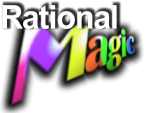

| The Power of Shazam! By Jerry Ordway. New York: DC Comics, 1994. 1v. (unpaged). $19.95; $9.95pa. ISBN 1-56389-085-2; 1-56389-153-0pa. |
|
GENRES: AUDIENCE: SYNOPSIS: Back in the US, homeless newsboy Billy Batson is taken by a mysterious stranger, via Egyptian/Art Deco subway, to a cavern, where he meets a bearded figure on a throne. The figure calls himself Shazam (wisdom of Solomon, strength of Hercules, stamina of Atlas, power of Zeus, courage of Achilles, speed of Mercury--good "Egyptian" figures all), names Billy his successor, and transfers his powers to the boy. Shazam! The boy becomes a super-powered man--a dead ringer for his father. He doesn't like this, though, and roughs up old Shazam until the mysterious stranger calms him down. The old Shazam is seemingly killed when Billy changes back to himself, and the mysterious stranger takes the boy back to the real world. Meanwhile, in a plush office, Sivana is questioned about the murders by Egyptian officials. Though Sivana claims that he too is a victim of circumstances and that there's no evidence that Adam was the killer, one of the officials is Saied, still alive but unable to speak--his throat had been slashed by Adam. When the men leave, Sivana enters a secret stairway to speak with Adam, who determines to kill these men by blowing up the radio station where they are to be interviewed. However, Billy is sleeping in the alley next to the station; he follows them onto the roof. They shove him off, but he returns as Captain Marvel and throws the dynamite away--unfortunately throwing it too hard; it doesn't land in the harbor but in Sivana's soon-to-be-open Fawcett City World's Fair. Then he returns to catch the bad guys, though Adam escapes. After accidentally changing to himself in mid-flight, landing on a Sivana dirigible, changing back, and blowing up the dirigible with his lightning, Billy rushes back to the subway, where he has a quick mental confrontation with the old Shazam before he comes to himself and is taken back to school by Mr. Dudley, the school custodian. Sivana is appalled by the destruction of his property and the angry charges made about him over the radio. He confronts Adam, who describes what happened and believes the super-powered figure to be CC Batson somehow. Then Adam takes out the necklace that he'd taken from the tomb and says "Shazam!" and becomes Black Adam, the evil version of Captain Marvel and the modern incarnation of Teth-Adam, Shazam's old enemy. He roughs up Sivana and leaves him to die in the fire that Adam's lightning started. Black Adam is determined to destroy both the Egyptians and his ancient enemy once and for all. EVALUATION: With Miracleman out there, what could possibly have been left to say about Captain Marvel? Maybe a great talent could have found something, but certainly Ordway didn't. The Power of Shazam embodies superhero cliches. From the dialogue (where, yet again, a man calls a woman a "cow") to the temple that crumbles over the characters' heads for no apparent reason to the superfight at the climax of the book, you and I have seen this stuff hundreds of times. Even the lettering is a cliche. (I've never understood the tendency of comic book letterers to emphasize every other word in a piece of text. This practice is carried to extremes here, with such travesties as "Listen, you ne'er do well--") The paucity of ideas extended into a ripoff of The Power of Shazam's superior predecessors. Like Lex Luthor, Sivana has been turned into a multimillionaire (though through the unthinking actions of Captain Marvel, he would be penniless at the end of the book). Like Miracleman, when Billy changes back and forth, his lightning now damages the world around him. Much has been ballyhooed about Ordway's fully painted art and that he spent two years on this book, but I found it flat and uninspired. Why go to all that trouble if you're just reproducing the standard superhero camera shots and action, the same sorts of lines and colors and silly poses that pencil and ink have been churning out for decades? There's no point in going into the numerous plot absurdities. Unnecessary, dull, and expensive, The Power of Shazam cannot be recommended to anyone. |
Return to Rational Magic Home
